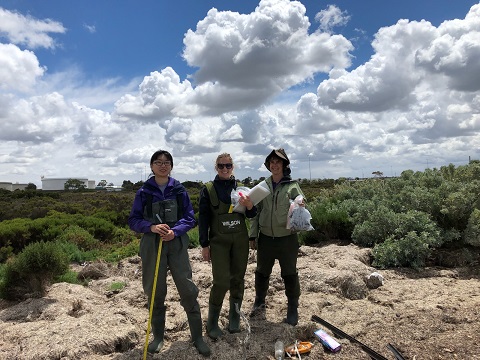Valuing the coastal protection services of green and grey habitats for public and private property
Summary
Coastal flooding due to extreme weather events causes significant social and economic impacts, globally. In Australia, between 2000 and 2012, storm damage cost insurers ˃ $16.1 billion AUD. Increasing coastal population and climate induced rising sea levels will exacerbate the impacts of coastal flooding into the future. Hence, there is an urgent social and economic need to develop better risk reduction and adaptive strategies to manage coastal flooding.
Artificial structures (e.g. seawalls) are the engineering industry standard for coastal protection. These structures can have negative impacts on coastal ecosystems and may not be cost-effective given their expensive and non-adaptive nature. In Victoria ~50% of the existing coastal defence structures need to be rebuilt, upgraded and maintained to protect private and public properties from coastal flooding.
There is growing recognition that natural coastal habitats, saltmarshes, mangroves, seagrasses can provide important protection to communities from coastal flooding and storms, through wave attenuation. They also offer significant economic advantages over traditional coastal engineering solutions because they can adapt to changes in climate, by increasing elevation in response to sea‐level rise, self‐repairing after storm events, and provide additional ecosystem services (e.g. nursery habitat for commercially important fish).
Aims and Activities
The protective services of these natural defences have not been assessed in the same rigorous economic terms as seawalls, and therefore are often overlooked by coastal managers. This project brings together a team that spans two faculties (Science, and Architecture, Building and Planning) and three research groups (NCCC, CEER, Thrive) from Uni Melb, a consultant and council partner to determine the role of existing coastal defence options: seawalls and natural habitats (saltmarshes, mangroves and seagrasses) for flood protection in the case study area of Hobsons Bay, Victoria.
The research will combine property, planning/architecture and ecological data, creating in a first for Australia, and even globally, an integrated approach for assessing the cost-benefits of different coastal defence options for property implications and value considerations.
The aims of this project are to:
1)Calculate the number of private and public properties at risk from coastal flooding.
2)Quantify the influence of seawalls and natural habitats in reducing the risk coastal flooding and the value implications for private and public properties.
3)Determine the cost-benefits of seawalls and natural habitats as coastal defence options.
Project Team
Dr. Elisabeth Strain, Lecturer in Marine Science, National Centre for Coasts and Climate, University of Melbourne
Dr. Rebecca Morris, Postdoctoral Researcher, National Centre for Coasts and Climate, University of Melbourne
Associate Professor Anthony Boxshall, Melbourne Enterprise Fellow – Integrated Environmental Research, University of Melbourne
Professor Tom Kompas, Economist, University of Melbourne
Dr. Karl Mallon, Director of Science and Systems at Climate Risk Pty Ltd.
Dr. Georgia Warren-Myers, Lecturer in Property & Valuation, University of Melbourne
Dr. Sareh Moosavi, Lecturer in Architecture, Building and Planning, University of Melbourne
Dr. Gideon Aschwanden, Lecturer in Urban Analytics, University of Melbourne
Dr. Judy Bush, Postdoctoral researcher, University of Melbourne
